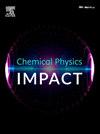Advanced TiO2-polypyrrole nanostructures enhance glucose detection accuracy with cutting-edge non-enzymatic electrochemical capabilities
IF 4.3
Q2 CHEMISTRY, PHYSICAL
引用次数: 0
Abstract
High level of glucose in the blood lead to a serious disease especially in the heart, blood vessels, eyes, kidney & nerves etc. in human and thus its detection has an important aspect in medical sector and food industry as well. According to World Health organization (WHO), it was speculated that the number of overall diabetes's patient will increase globally by 2025. Thus, there is a notable need for the glucose sensors that may give quick response, extremely sensitive and economically sound to the regular blood glucose monitoring. In this study we have developed and deigned a cheapest, reliable and high performance TiO2-Polypyrrole (TiO2-PPy) nanocomposite based non-enzymatic electrochemical sensor for glucose detection. This hybrid nanostructured material has shown excellent electro catalytic properties toward glucose oxidation due to its high surface area. The resulting material were characterized by an optical and electrochemical techniques to validate its structural architecture and catalytic activity. Electrochemical studies revealed that the TiO2-PPy nanocomposite based sensor exhibited remarkable stability and sensitivity towards non-enzymatic glucose detection. The developed non-enzymatic glucose detection sensor demonstrated sensitivity of 678.57 μAmM−1cm2 with linear range of 0 mM to 5.5 mM The enhanced performance is attributed to the synergistic effects of both the metallic as well as polymer moieties in the nanocomposite, where polypyrrole provides an outstanding conductive network for an efficient electron transfer, while TiO2 offers an active Centre for oxidation of glucose molecule. Additionally, TiO2-PPy the sensor confirmed the excellent stability and reproducibility, along with strong potential for practical application in real sample analysis. Therefore, the proposed nanocomposite holds great promise for the development of sustainable and environmentally friendly glucose sensing devices.

先进的tio2 -聚吡咯纳米结构提高了葡萄糖检测精度与尖端的非酶电化学能力
血液中葡萄糖水平过高会导致严重的疾病,特别是在心脏、血管、眼睛、肾脏等方面。人体神经等的检测在医疗和食品工业中也具有重要的意义。据世界卫生组织(WHO)推测,到2025年,全球糖尿病患者总数将增加。因此,对快速、灵敏、经济的常规血糖监测血糖传感器的需求十分迫切。在这项研究中,我们开发和设计了一种最便宜、可靠和高性能的基于tio2 -聚吡咯(TiO2-PPy)纳米复合材料的非酶电化学葡萄糖传感器。这种杂化纳米结构材料由于其高表面积而表现出优异的葡萄糖氧化电催化性能。利用光学和电化学技术对所得材料进行了表征,以验证其结构和催化活性。电化学研究表明,TiO2-PPy纳米复合材料传感器对非酶促葡萄糖检测具有良好的稳定性和敏感性。该非酶促葡萄糖检测传感器的灵敏度为678.57 μAmM−1cm2,线性范围为0 ~ 5.5 mM。性能的增强归功于纳米复合材料中金属和聚合物部分的协同作用,其中聚吡咯为有效的电子转移提供了出色的导电网络,而TiO2为葡萄糖分子的氧化提供了活跃的中心。此外,TiO2-PPy传感器具有良好的稳定性和再现性,在实际样品分析中具有很强的应用潜力。因此,所提出的纳米复合材料对于可持续和环境友好型葡萄糖传感装置的发展具有很大的前景。
本文章由计算机程序翻译,如有差异,请以英文原文为准。
求助全文
约1分钟内获得全文
求助全文
来源期刊

Chemical Physics Impact
Materials Science-Materials Science (miscellaneous)
CiteScore
2.60
自引率
0.00%
发文量
65
审稿时长
46 days
 求助内容:
求助内容: 应助结果提醒方式:
应助结果提醒方式:


